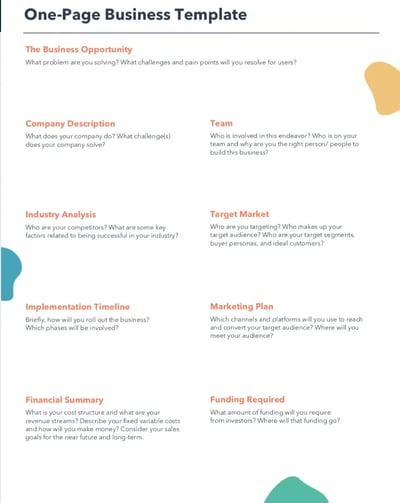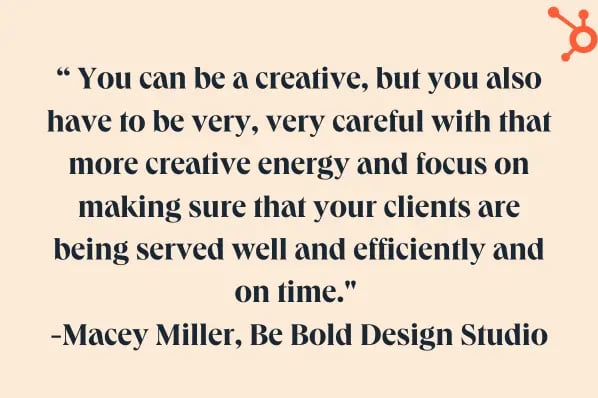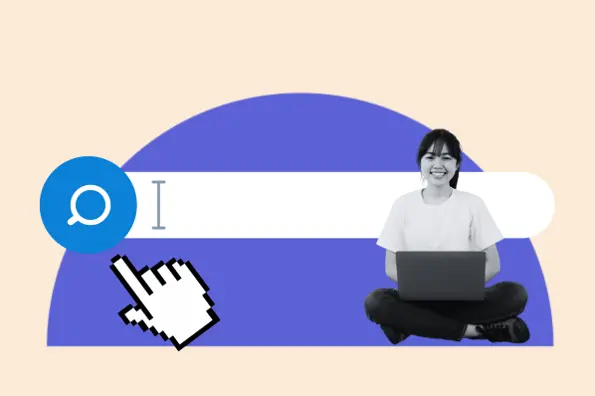Have you heard the expression, "If it were easy, everyone would do it?" That saying certainly applies to starting your own business. However, with the right preparation, you'll discover that learning how to start a web design business isn't as hard as you might think.

I talked to two web design business owners who filled me in on everything you need to know about how to start a web design business. I'll walk you through the steps you'll take, plus some pro tips to help you make your launch a success.
How to Start a Web Design Business: 15 Steps
- Figure out your working arrangements.
- Identify your website design business niche — if you have one.
- Pick a name.
- Create a mission statement.
- Determine what you want to offer.
- Establish a business plan.
- Seek legal advice.
- Check off administrative tasks.
- Identify pricing.
- Make your branding.
- Create templates and establish workflows.
- Design your website.
- Start building your social presence.
- Train yourself on anything you're not sure about.
- Network in person and online.
Whether you are figuring out how to start a web design business from home or eventually want to open up your own brick-and-mortar location, there are a lot of items to check off before you're ready to take on clients. Here are 15 steps you can follow when learning how to start a web design business.
1. Figure out your working arrangements.
Your first step is to figure out your working arrangements. Will you work from home or rent out an office space? Will you interact with clients virtually or offer a brick-and-mortar location where you can meet? And if you're working from home, do you have a professional, private space where you can conduct business?
It's possible to learn how to start a web design business from home, but by addressing these questions upfront, you'll know how to better set your business up for success.
Mindy League, UX Director at Elevated Third, owned a web design agency that one of her clients went on to acquire. She knows her stuff — League has worked in digital marketing with B2B giants, including HP, IBM, Thermofisher, and more. When recounting her experience as a web design business owner, League mentions that she feels it's easier to start a business now in a world where working from home is normalized.
She recounts, in a pre-pandemic world, needing to have a brick-and-mortar storefront where she could work with her team or meet clients. "Now, we have this really more acceptable work from home," she says. "I think it would be easier to start a business now than it was then. Because [then] it was expected that you had a brick and mortar, which was a high cost, a high expense. It was almost validating that you're in business."
Once you've figured out your physical working arrangements, consider your hardware and software arrangements too. When learning how to start a web design business from home, keep in mind that you'll need all the bells and whistles you would in an office, such as a comfortable seat, functioning computer, and monitor, if you like using one.
You may need to purchase a new laptop or monitor for your web design business work. Or, maybe you'll need to sign up for Adobe Creative Suite subscriptions. If you're not launching your business ASAP, you don't need to sign up for the software right away to avoid paying for it when it's not in use. However, you should have your physical hardware ready to go.
Pro Tip: I know that bills can quickly add up when you're first starting a business. If you're buying a computer, I recommend considering a lightly used one as they're reasonably priced. Or, purchase a gently used desk from a local thrift store to cut costs. What matters most is that your equipment is reliable.
2. Identify your website design business niche — if you have one.
Niche or no niche, that's the question. There are pros and cons to both — if you choose a niche, you can become the best in that industry and establish a reputation. Alternatively, if you don't choose a niche, you can garner a large pool of clients across industries.
One way isn't better than the other; they're just different.
Macey Miller, the owner of Be Bold Design Studio, has created websites for "all kinds of businesses," though much of the sites she's made have been for woman-owned companies. Miller initially became interested in website design because she wanted a creative outlet when working in marketing at a hospitality technology company. You should trust her advice because, since starting her business in 2018, she's created more than 120 websites. What started out as a side gig became so successful that Miller was able to quit her full-time salaried role in six months.
"I have a lot of friends who own businesses, and they need websites," she shares. "And so I started my business out of really an outlet for creativity, but then also as friends and family needed websites and logos and designs. I was always like, yeah, I can hop in. I'll do that. It was a nice break after all the analytical meetings and just all the things that came with …marketing."
Pro Tip: If you're stuck, let your portfolio and professional experience inform your decision about whether you'll pursue a niche subcategory of website design or offer more holistic services. If you only have experience creating websites for consumer packaged goods products (CPG), stick with the CPG industry. Or, if you've created websites for educational institutions, food and beverage, entrepreneurs, and more, you may consider sticking with a no-niche agency.
3. Pick a name.
I know — picking a business name is tricky! It should be descriptive but not too long. Reflective of your mission, yet clever. Unique but simple. That's a lot to keep in mind. (Psst: If you need help selecting your business name, check out these 300+ examples of business names we love for inspiration.)
In some cases, you may want to use your own name as the title of your business. If you believe yourself to be the face of your brand, then maybe, using your name is a good idea. Of course, there's also the search engine optimization (SEO) value if you have an uncommon name.
I advise you to test out your business names in front of family, colleagues, or friends. You can run a poll on LinkedIn to ask others in the industry which they prefer. Picking a moniker is a serious commitment, so be sure you're willing to stick with it for a while.
Pro Tip: I suggest doing some research before you commit to your name. When you Google it, if a lot of other agencies pop up, you might want to pick an alternative. If there are already a ton of other businesses with the name, you'll have a hard time securing social media handles, too.
4. Create a mission statement.
Before you begin ideating your company mission statement, I suggest you check out some examples from businesses you admire. (May I humbly suggest HubSpot?)
36c2.jpg)
I also love Be Bold Design Studio's mission statement. It's straightforward, focused on impact, and I love how Miller clearly displays it on the footer of the studio's homepage.
ff83.png)
Your mission statement doesn't have to be too long or intricate. The best mission statements are straightforward and succinct, and they showcase your company's values.
Pro Tip: You can include your mission statement on your homepage, footer, or on its own page, depending on how much emphasis you'd like to place on it.
5. Determine what you want to offer.
You have your name, mission statement, and niche all picked out. Your next step is determining what you want your business to offer. Ultimately, you can make your business as all-encompassing (or niche) as you want. Do you want to offer complete website design services that include add-ons such as branding and logo design or photography? Or do you want to work mainly on website rebuilds? What about maintenance — do you want to offer it or leave clients to their own devices?
It is your business — so you can decide what you want to offer based on both your skills and experience. However, keep in mind that if you don't have a well-rounded menu of offerings, clients may take their business elsewhere, where they can get their website created, logos created, and branding established all in one place.
Pro Tip: If you're building your business with a co-founder, League suggests that you consider picking someone with expertise in the opposite of what you do. "When you're getting started, you don't necessarily think of looking for someone who does the opposite of what you're doing," she says. However, by thinking about this in advance, you can reduce the likelihood that you'll need to outsource help. (Psst: That doesn't only apply to business offerings. For instance, if you have the creative portion under control, consider working with someone more analytical who can tackle the finances.)
6. Establish a business plan.
In my opinion, writing up a business plan is arguably the most daunting part of learning how to start a web design business. The good news? You don't have to do it yourself — this robust guide to creating a business plan will offer you a life raft.
Your business plan should provide a clear summarization of your organizational strategy for success. You can use your business plan to acquire funding from investors or help forecast your business demands. Most importantly, when starting out a business, your business plan should highlight your goals and the way you plan to achieve them. This is also where you'll tie in your mission statement and business purpose.
If you're feeling overwhelmed by the prospect of writing your business plan, use one of our free templates to set you on the right track. For example, I love this one page business plan template.

It's concise, asks the right questions, and makes it easy for you to keep all your crucial information in one handy location. You can download it here.
Pro Tip: Taking a look at other business's plans can help you figure out how to build out your own. Here are 24 sample business plans to get your creative juices flowing.
7. Seek legal advice.
Congratulations; you're about halfway through the process of learning how to create your web design business from home. Give yourself a pat on the back — and take a deep breath because it can be overwhelming.
Before you go any further in your business ownership journey, it's time to seek legal advice. Your best option is to find a lawyer who has experience working with small businesses and helping ensure they're compliant with all the laws in your jurisdiction. You may need a license to operate your business, depending on what it is and where you live. Or, you might need help deciding whether you want to be a sole proprietor, open an LLC, or start a corporation.
While no one likes shelling out cash for legal fees, the repercussions of not doing so and accidentally violating a law can be massive. Your lawyer can also help you draft the contracts that you'll share with clients when entering into an agreement with them. Getting liability insurance for your business is also a good idea, and your lawyer can advise more on the steps you should take to do so.
Pro Tip: Lawyer fees can be expensive — especially when you're just starting out. If the cost of working with a lawyer is prohibitive, I recommend you try to find one willing to do the work pro bono. I'll admit, it can be tricky to find a lawyer that'll do the work for free. But ask around — you may have a connection willing to help out.
8. Check off administrative tasks.
I told you learning how to start a web design business isn't always glamorous, didn't I? I promise it will be well worth it. Your next step is to complete various administrative tasks you need to check off your list before your business can open its doors.
For example, now that you're starting your own business, you'll need to think about how you're going to get health insurance. Maybe you can still be on your parent's insurance, or you have a partner who can take you under their wing. However, if this isn't the case, you need to think through the ways you'll be able to get healthcare.
I know this doesn't seem directly related to starting your own web design business, but it's an important administrative task you need to check off. When you're just starting out, you'll only need to think about getting healthcare for yourself. But if your business grows and you hire teammates, you'll have to think about their insurance, too.
The next thing you'll want to think about is your retirement plan. You can consider opening a Roth IRA or a Health Savings Account. (Of course, if you want more guidance about what's best for your financial future, I suggest you speak with a financial advisor who better understands your particular situation.)
Lastly, think through your holiday and vacation policy. You're your own boss now, which means you'll have to be accountable for getting stuff done. Creating a clear vacation and holiday plan is an excellent way to keep you on the right track. Miller believes that holding herself accountable for getting work delivered in a reasonable amount of time is partially why her business has flourished. "I think it is very important to… be true to your word," she says.
Miller continues, "If you say you're going to deliver something on Tuesday, you need to deliver something on Tuesday. A lot of times with a website design business, you know, it's creatives, and it's hard to pin us down within the website design business. You can be a creative, but you also have to be very, very careful with that more creative energy and focus on making sure that your clients are being served well and efficiently and on time."

Pro Tip: If you're struggling with administrative tasks, I highly recommend talking to other small business owners you know who have taken their business full-time to learn more about how they handled administrative tasks when starting out.
9. Identify pricing.
Now that you know what you have to offer, it's time to decide how much you're going to charge for it.
Your first step when identifying pricing is to take a look at your competitors' pricing. How much is your competition charging for a website, logo design, branding, and bespoke photography? What about a site refresh? Find out, and make notes of what your top 5-10 competitors are charging. This will inform your rates. I suggest creating a spreadsheet that clearly identifies competitor pricing.
You'll also have to decide if you want to charge a flat rate for a project or hourly. If you go the project route, consider how many hours it will likely take to complete the project and break that down into hourly wages. Remember: You deserve to pay yourself a livable salary.
Now that you've done your research, consider your business's overhead. Do you have to pay for your space? Have you thought about how taxes factor in? How about the software you'll need to run your business? Did you include your insurance fees when factoring in how much it costs to run your business?
From there, you can subtract your overhead per project from the rate you're thinking of charging. This leaves you with your profit.
Pro Tip: Adding testimonials to your website can help you feel more confident about your rates. These testimonials demonstrate the value of your work, and you can easily point to them when conferring with potential clients about budget. For some inspiration, check out HubSpot's Customer Reviews page.
10. Make your branding.
We're finally at a fun part of the web design business creation process. You'll have to make your branding before you begin to share the news of your business online. You're a creative, so you likely already know exactly what to do, but here are a few branding tips in case you need them:
-
Consistency is key — choose a color palette, style of photography, and a few fonts. Then, stick with them. This will give your business a professional flair.
-
Create a logo that's not too detailed. If it is, the details will get lost when you shrink it down.
-
Try to avoid already popular color pairings because they'll subliminally remind your visitors of other, more famous brands. For instance, red and yellow may not be the best bet for your company because these colors together conjure up images of Ronald McDonald.
Pro Tip: Need a dose of inspiration for your business's color palette? These color pairings are sure to wow.
11. Create templates and establish workflows.
Yes, you have your branding, pricing, and business plan — but you are not open for business yet. First, it's essential to create templates and establish workflows. That way, when you do get your client (and trust me, it will happen), you already have a handle on how to get them onboarded.
Using a project management tool can help you create workflows that hold you accountable and ensure you deliver results on time. I love Asana, Trello, and Notion, so experiment to find one that works best for you and is within your budget.
This is also the time for you to make sure those contracts you worked with your lawyer to create are ready to go. Plus, create a checklist for client onboarding, the steps you'll follow to launch a client website, and make any necessary supporting documentation or templates. You should also have your invoice template in place. If you do all of this, professional is the name of your game.
Last but certainly not least, determine how you're going to track your time. It's not enough to set an iPhone timer — you need to keep track of your time and how you spend it. There are plenty of time-tracking apps available, some of which even integrate directly with your project management tools.
Pro Tip: By having your onboarding checklist ready to go, you'll be ready the moment your first client comes knocking. Plus, you'll score major points with your client for preparedness and professionalism.
12. Design your website.
You already know how to do this, so I'll leave this one to you. And if you want some sources of inspiration, you know where to find them — here, where I identified the 25 best creative agency websites.
Just to recap, here are some key things to keep in mind when designing your website.
-
Were created with search engine optimization (SEO) in mind.
-
Include mindful CTAs, or calls to action. (Psst: You shouldn't only have one place for visitors to go to reach out to you — that CTA should be sprinkled throughout your site so visitors can contact you the moment they feel inclined to.)
-
Feature cohesive branding.
-
Have testimonials and examples of past work.
-
Have a sense of personality so visitors know who you are and why they should trust you with their website.
-
Hire a proofreader or ask a family, friend, or mentor to look over your site. Ask them to read through it for clarity and accuracy.
-
Consider having a blog on your website and writing posts that target keywords.
Your goal on your business website is to reduce friction in any way that you can.
Pro Tip: About 42.5 million Americans have disabilities. Don't ignore website accessibility best practices when building your website.
13. Start building your social presence.
You're almost at launch day, congrats. It's time to start building your social presence. Whether you contribute to collaborative articles on LinkedIn to showcase your web design expertise, create your own X/Twitter posts with a link to your portfolio site, or begin filming trendy TikToks about web design misconceptions, the internet — erm, I mean the world — is your oyster.
When deciding which social media platforms you want to hone in on, consider this:
-
Where is my audience?
-
What platform can I go viral on? (TikTok is great for this because, regardless of whether you have five followers or five million, you can go viral.)
-
What platform feels intuitive for me to use?
-
How can I best tell my brand story?
Pro Tip: Ideally, you'll be able to create content for multiple social media platforms. However, focusing on one or two will help reduce stress. Dial in on wherever you're seeing the largest return on investment for your time.
14. Train yourself on anything you're not sure about.
Maybe you're a natural-born designer, but sales calls don't come easy for you. Or maybe you've always loved rebuilding websites, but you struggle with offering bespoke logo design services. Everyone has their strengths and weaknesses — but your weaknesses don't have to stay weaknesses. You can decide to seek out training to teach yourself more about anything you're unsure about.
"I think it's easy for people to say like, well, I'm not good at admin, or I'm not good at sales calls, and that's just an excuse," says Miller. "Why don't you go in and learn how to do a sales call? Like I've done two to three sales trainings, which has been very helpful because sales is a part of owning your own business. And if you're not comfortable with selling in a way that is natural and authentic but also just natural and authentic to you, then you won't be able to last."
Pro Tip: HubSpot Academy has plenty of free courses that can help teach you more about different facets of marketing, sales, and beyond. You can even earn free certifications, which look great when you're trying to build authoritativeness. I've done several courses, and I found them to be both educational and engaging.
15. Network in person and online.
You did it! You've successfully created your own web design business. I hope you're proud of yourself because I'm proud of you.
Now, it's time to share the incredible news with your family, friends, colleagues, and mentors. Remember to bring business cards with you when you meet with people, and bring along extras so your friends can pass them along to their friends. You never know who may be your first client.
Online, you can spread the word on your personal and professional social media accounts. You can also reach out to any business owners you know and let them know you're open for business if they wish to enlist your help.
Pro Tip: Keep your mind open when it comes to finding clients. You never know how your clients will make their way to you — just trust that they will. Be sure to spread the word so everyone you know can have their feelers out in case anyone they know needs a designer.
What are 5 tips for people starting a web design business?
These five tips from Miller and League — who have actually gone through the process of building a web design business themselves — can help set you up for success.
Remember that potential clients are everywhere.
League recounts that when she owned her agency, she was living in Austin, Texas, where she had a large network. "There were a lot of folks that I knew," she says. "And so I would just make new clients at the retail stores, or wherever I was, I would just meet people. Or they knew someone, and then we referred." A valuable lesson to keep business cards with you at all times indeed.
38eb.jpg)
Give back to your clients.
League also suggests the idea of using "swag" to gain momentum for your business. "We gave a lot to our customers," she says. "We had parties and gave them swag. So when we had profit, we really gave them things that we thought they would enjoy. We [were] really appreciative of them. We were constantly giving them mugs, and we made up cute campaigns around it, like a social media campaign. [With the cups, we asked clients to] send us your 'mug shot.'"
Keep in mind that things ebb and flow.
The reality of owning your own business is that things will ebb and flow; there will be busy seasons and slower ones. However, to keep your business afloat during tougher times, Miller suggests you get creative. "There are a lot of different ways to make money as a website designer," she shares. "One tip is being open to potentially white labeling. There are a lot of agencies that white-label their services and that need freelance graphic designers to kind of come in and help with the workload.
When you start your own business, a lot of times you think, oh, it's just going to be me, all by myself. I'm going to be getting all these clients, but in those slow seasons, it's nice to lend your services to an agency or even take on some retainer clients and do maintenance work or graphic design work."
Customer service speaks for itself.
Another key learning from Miller? That customer service really can set you apart from your competition. "I found that the reality of building a healthy business and a client base requires serving your clients, marketing, networking, and a strong online presence, but really more focusing on serving your clients," she says.
"A lot of people focus more on the design and the creative part, but I truly believe that customer service is almost as equally important as the beauty of creative design. It takes time to build a client base and to establish a reputation."
Expect to wear a lot of hats.
Depending on the client, you may have to wear more hats than just the assigned "web designer." For instance, League mentions that entrepreneurs are sometimes more anxious regarding where their money is going than large corporations, as it's their hard-earned cash they're spending.
"They would get really nervous before the launch because it was the unveiling of their idea," she explains. "And so that, that was something I didn't realize, [that] I had to be so much of a psychologist, making that transition from the bigger agency, you know, to the smaller agency. There was a lot more psychology. Granted, when you work with an agency or with any client, you have to worry, think of, and be empathetic towards them."
Bring Your Web Design Dream Business to Life
You officially know how to start a web design business, and it's up to you to decide if you're ready to take that next step toward becoming your own boss. When building your company, keep your why in mind, and commit to customer service. If you do these two things, you can't go wrong.


-1.png)
-1.png)

.jpg)




-1.png)
